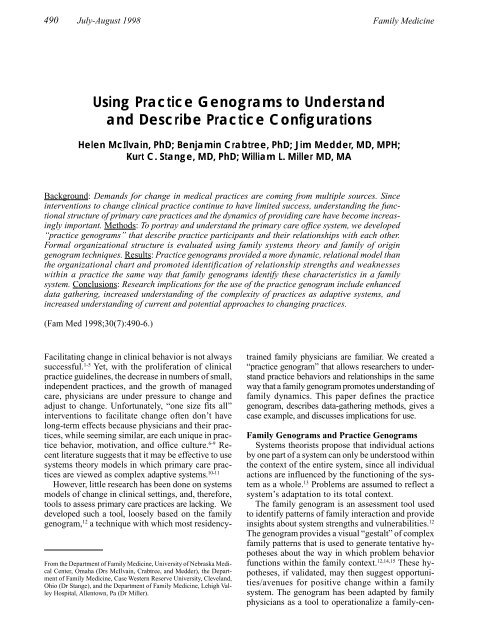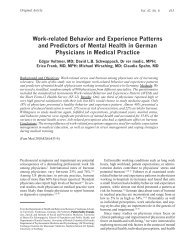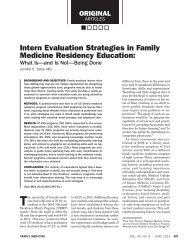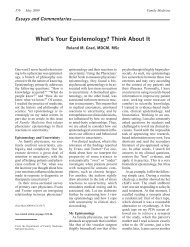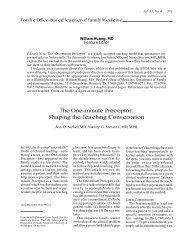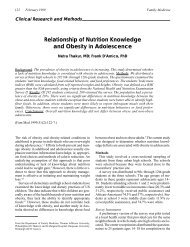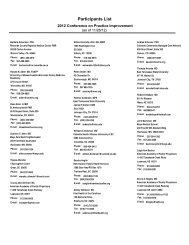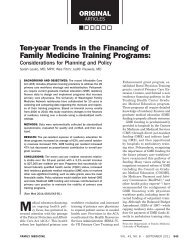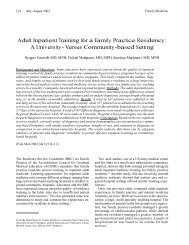Using Practice Genograms To Understand And Describe ... - STFM
Using Practice Genograms To Understand And Describe ... - STFM
Using Practice Genograms To Understand And Describe ... - STFM
Create successful ePaper yourself
Turn your PDF publications into a flip-book with our unique Google optimized e-Paper software.
490 July-August 1998 Family Medicine<br />
<strong>Using</strong> <strong>Practice</strong> <strong>Genograms</strong> to <strong>Understand</strong><br />
and <strong>Describe</strong> <strong>Practice</strong> Configurations<br />
Helen McIlvain, PhD; Benjamin Crabtree, PhD; Jim Medder, MD, MPH;<br />
Kurt C. Stange, MD, PhD; William L. Miller MD, MA<br />
Background: Demands for change in medical practices are coming from multiple sources. Since<br />
interventions to change clinical practice continue to have limited success, understanding the functional<br />
structure of primary care practices and the dynamics of providing care have become increasingly<br />
important. Methods: <strong>To</strong> portray and understand the primary care office system, we developed<br />
“practice genograms” that describe practice participants and their relationships with each other.<br />
Formal organizational structure is evaluated using family systems theory and family of origin<br />
genogram techniques. Results: <strong>Practice</strong> genograms provided a more dynamic, relational model than<br />
the organizational chart and promoted identification of relationship strengths and weaknesses<br />
within a practice the same way that family genograms identify these characteristics in a family<br />
system. Conclusions: Research implications for the use of the practice genogram include enhanced<br />
data gathering, increased understanding of the complexity of practices as adaptive systems, and<br />
increased understanding of current and potential approaches to changing practices.<br />
(Fam Med 1998;30(7):490-6.)<br />
Facilitating change in clinical behavior is not always<br />
successful. 1-5 Yet, with the proliferation of clinical<br />
practice guidelines, the decrease in numbers of small,<br />
independent practices, and the growth of managed<br />
care, physicians are under pressure to change and<br />
adjust to change. Unfortunately, “one size fits all”<br />
interventions to facilitate change often don’t have<br />
long-term effects because physicians and their practices,<br />
while seeming similar, are each unique in practice<br />
behavior, motivation, and office culture. 6-9 Recent<br />
literature suggests that it may be effective to use<br />
systems theory models in which primary care practices<br />
are viewed as complex adaptive systems. 10-11<br />
However, little research has been done on systems<br />
models of change in clinical settings, and, therefore,<br />
tools to assess primary care practices are lacking. We<br />
developed such a tool, loosely based on the family<br />
genogram, 12 a technique with which most residency-<br />
From the Department of Family Medicine, University of Nebraska Medical<br />
Center, Omaha (Drs McIlvain, Crabtree, and Medder), the Department<br />
of Family Medicine, Case Western Reserve University, Cleveland,<br />
Ohio (Dr Stange), and the Department of Family Medicine, Lehigh Valley<br />
Hospital, Allentown, Pa (Dr Miller).<br />
trained family physicians are familiar. We created a<br />
“practice genogram” that allows researchers to understand<br />
practice behaviors and relationships in the same<br />
way that a family genogram promotes understanding of<br />
family dynamics. This paper defines the practice<br />
genogram, describes data-gathering methods, gives a<br />
case example, and discusses implications for use.<br />
Family <strong>Genograms</strong> and <strong>Practice</strong> <strong>Genograms</strong><br />
Systems theorists propose that individual actions<br />
by one part of a system can only be understood within<br />
the context of the entire system, since all individual<br />
actions are influenced by the functioning of the system<br />
as a whole. 13 Problems are assumed to reflect a<br />
system’s adaptation to its total context.<br />
The family genogram is an assessment tool used<br />
to identify patterns of family interaction and provide<br />
insights about system strengths and vulnerabilities. 12<br />
The genogram provides a visual “gestalt” of complex<br />
family patterns that is used to generate tentative hypotheses<br />
about the way in which problem behavior<br />
functions within the family context. 12,14,15 These hypotheses,<br />
if validated, may then suggest opportunities/avenues<br />
for positive change within a family<br />
system. The genogram has been adapted by family<br />
physicians as a tool to operationalize a family-cen-
Educational Research and Methods<br />
tered biopsychosocial approach to care. 16 Particular<br />
emphasis is placed on emotional connections among<br />
family members, across generations, and with important<br />
individuals or systems outside of the family system.<br />
Constructing a genogram involves three activities:<br />
1) visually mapping the structure of a family, 2)<br />
recording important information, ie, demographics,<br />
critical events, and crucial issues, and 3) showing<br />
emotional relationships and informal roles among<br />
members of the family.<br />
Increasingly, organizations are being viewed as<br />
complex, adaptive systems “that are conscious entities,<br />
possessing many of the properties of living systems.”<br />
17 The commonly used “machine” metaphor<br />
that emphasizes structure and parts is no longer adequate.<br />
Instead, organizations are now studied as<br />
“whole” systems, especially when considering<br />
change. 10 As family therapists discovered with families,<br />
to comprehend fully the “gestalt”of an organizational<br />
system, it is helpful to visualize the organization<br />
in terms of its complex relationships.<br />
Organizational charts can be used to understand<br />
how a practice functions; however, they are more<br />
likely to indicate how things are supposed to be than<br />
how they really are. Organizational charts rarely identify<br />
the informal, emotional, and relational patterns<br />
that are obvious to anyone who has ever worked in<br />
an organization. <strong>Genograms</strong> give that information,<br />
expanding a basic organizational chart into a more<br />
useful tool. It seemed a reasonable extension for us<br />
to use this tool to understand the organizational dynamics<br />
that could promote or prevent the implementation<br />
of change at the practice level. In constructing<br />
our practice genograms, we use similar concepts and<br />
terminology (Figure 1) to those used by McGoldrick<br />
and Gerson. 12<br />
Development of the <strong>Practice</strong> Genogram<br />
Since 1994, researchers in the departments of family<br />
medicine at the University of Nebraska Medical<br />
Center (UNMC) and Case Western Reserve University<br />
(CWRU) have been collaborating in the analysis<br />
of preventive service data from 82 primary care practices<br />
in northern Ohio. 18 Concurrently, UNMC researchers<br />
were initiating an intervention study in eight<br />
Nebraska family practices using the Put Prevention<br />
into <strong>Practice</strong> materials. 7 In the process of assessing<br />
those eight practices, one of the authors started informally<br />
using the genogram technique to keep track of<br />
the individuals involved in the practices and their formal<br />
and informal relationships to one another. This<br />
helped us understand the strengths and weaknesses<br />
of each system relative to the intervention. Although<br />
not formally used in all 82 Ohio practices, our knowledge<br />
of these practices provided an opportunity for<br />
discussion and expansion of the genogram concept.<br />
We currently have experience using the practice<br />
genogram in 59 locations, ranging from simply de-<br />
Figure 1<br />
Vol. 30, No. 7<br />
Symbols Used in <strong>Practice</strong> <strong>Genograms</strong><br />
491<br />
scribing some practices to interventional changes in<br />
others. These experiences are described in more depth<br />
as follows.<br />
The Nebraska Experience: <strong>Practice</strong> <strong>Genograms</strong><br />
Through Participant Observation<br />
The UNMC experience was designed to provide<br />
detailed descriptions of practices to understand their<br />
processes for providing preventive care. We used a<br />
case study framework employing a multi-method ethnographic<br />
data collection approach. 19-21 Research sites<br />
were told that we would like to study their practices<br />
and delivery of preventive services to better understand<br />
the barriers and facilitators to providing preventive<br />
care in real-life practices. Methods of data<br />
collection and analysis, including the genogram, were<br />
discussed prior to the practice agreeing to participate.<br />
<strong>Practice</strong>s were told that they would be given a summary<br />
of their prevention practices, including the<br />
genogram, at the end of the analysis.<br />
Primary data were participant observation field<br />
notes, 22-24 key informant interviews, 25,26 in-depth interviews<br />
of physicians and office staff, 27,28 documents<br />
used in the practice, 29 and medical record reviews. A<br />
research nurse collected these data as she observed<br />
practice activities. Observational field notes and key<br />
informant interviews were the primary data used to<br />
understand behavioral patterns within the practices.<br />
Field jottings (short reminders) taken during observation<br />
and clinical encounters were later expanded<br />
into more extensive field notes describing the research
492 July-August 1998 Family Medicine<br />
nurse’s impressions of the practice.<br />
Informal, unstructured key<br />
informant interviews with office<br />
personnel were undertaken to<br />
clarify observations. By reading<br />
the notes, the investigators got<br />
a sense of the practice before<br />
working with the research nurse<br />
to construct the genogram.<br />
Once the research nurse was<br />
in the practice long enough to<br />
understand the basic practice environment,<br />
the research team<br />
interviewed her to construct the<br />
genogram. We found that a<br />
large, easily erased white board<br />
is the best place to work on initial<br />
drafts of genograms. The<br />
organizational chart format was<br />
used, starting with the assumed<br />
hierarchy of authority and responsibility<br />
that would be expected<br />
with a given set of related<br />
roles (Figure 2). The research<br />
nurse was asked to identify all<br />
participants in the practice and<br />
their roles. Demographics of the<br />
Figure 2<br />
<strong>Practice</strong> Genogram Formatted in Organizational Chart Format<br />
Figure 3<br />
<strong>Practice</strong> Genogram With Relationships and Footnotes Obtained After 2 Days of <strong>Practice</strong> Observation<br />
FOOTNOTES:<br />
1. “Bee in bonnet” about prevention—<br />
wants to make changes
Educational Research and Methods<br />
individual members were elicited, including age, gender,<br />
number of years with the practice, current and<br />
past job responsibilities, percentage of time employed,<br />
and any characteristic personality traits identified<br />
during data gathering. Individuals or groups outside<br />
of the practice that significantly influenced the system<br />
were also included (eg, other clinics in Figure 3).<br />
Once the basic genogram structure had been constructed,<br />
it was expanded by asking the research nurse<br />
about functional and emotional relationships observed<br />
in the practices. Information was gathered in areas<br />
indicated by the questions listed in Table 1, which<br />
were developed from our own experience and from<br />
recommendations outlined in Webber et al. 30 A footnote<br />
process was used to highlight important information<br />
about a group or individual. Once the pen and<br />
paper version of the genogram was completed, computerized<br />
practice genograms were prepared using<br />
Visio ® 4.0, a software program specifically designed<br />
for creating flowcharts, network diagrams, organization<br />
charts, and cause-and-effect diagrams (Version<br />
4.0, 1995, Visio Corporation, Seattle, 206-521-4500).<br />
We have found that the length of time spent in the<br />
field has an impact on the depth of understanding.<br />
Figure 4<br />
Vol. 30, No. 7<br />
More Complex <strong>Practice</strong> Genogram Obtained After 2 Weeks of <strong>Practice</strong> Observation<br />
FOOTNOTES:<br />
1. “Bee in bonnet” about prevention—<br />
wants to make changes<br />
2. Left in 1992 after 7 years because of<br />
conflict with practice—now works<br />
for competing practice<br />
3. Considering retirement in a few<br />
years<br />
4. Concerned about practice survival if<br />
MD #1 retires and MD #2 leaves<br />
5. Supports projects of MD #1<br />
493<br />
Figure 3 shows a typical genogram after 2 days in a<br />
practice. Positive relationships were readily discernible,<br />
but there were no conflicts identified. After more<br />
extensive time at the practice (2 weeks), the picture<br />
became more complex (Figure 4), and some conflicts<br />
came to light. In our experience, it required a minimum<br />
of 1–2 weeks in the practice, depending on the<br />
number of physicians and staff, to get these types of<br />
details. Anecdotally, we have given reports to six of<br />
the 11 practices. In five of those six, we received positive<br />
feedback about the perceived validity of our<br />
analysis, including the genogram.<br />
The Case Western Experience: <strong>Practice</strong> <strong>Genograms</strong><br />
as Interview Guide<br />
Researchers at CWRU developed an alternative<br />
approach to practice genograms for their clinical trial,<br />
Study to Enhance Prevention by <strong>Understand</strong>ing <strong>Practice</strong><br />
(STEP-UP). This trial sought to increase prevention<br />
activities in randomly selected practices by tailoring<br />
office-level interventions based on a 2-day<br />
assessment of office practices. In the STEP-UP protocol,<br />
an initial practice genogram was completed by<br />
a research nurse during her first visit to each prac-
494 July-August 1998 Family Medicine<br />
Table 1<br />
Questions Used to Construct <strong>Genograms</strong><br />
• Who are the key members of the organization and what are their roles<br />
(formal and informal)?<br />
• What are the demographics for these individuals (age, gender, length<br />
of employment, etc)?<br />
• What are the important hierarchies, coalitions, triangles, and boundary<br />
problems in the organization?<br />
• How do the individuals and subsystems relate to each other with respect<br />
to professional roles and personal relationships?<br />
• What stage of the “life cycle” is the system in?<br />
• What are the important recent events or historical events that have<br />
shaped the practice?<br />
• How has the organization responded to recent changes?<br />
• What are the implicit and explicit belief systems within the practice?<br />
• Who are the most overtly and covertly powerful people in the system?<br />
• What is the overall communication style?<br />
• How is power shared in the system?<br />
Table 2<br />
STEP-UP Interview Guide for Developing a <strong>Practice</strong> Genogram<br />
Opening statement<br />
“I’m _____ from STEP-UP project. The practice is participating in _____. My role in STEP-UP is<br />
_____. I’m drawing an organizational chart to help me understand your practice.”<br />
Initial questions Follow-up questions<br />
“Who works here?” Demographics<br />
“Who works with whom?”<br />
“Who’s in charge?” “Who makes decisions:<br />
about patient care?”<br />
about personnel issues?”<br />
about office operations?”<br />
“Who reports to whom?” “Who supervises?”<br />
“Who can tell people what to do?”<br />
“How do the physicians communicate with each other? “Who are most powerful?”<br />
“How do physicians and staff communicate?”<br />
“How do staff members communicate?” “If you really want something done, who<br />
do you go to?”<br />
“What are recent events or changes?” “Who has left?”<br />
“Who owns the practice?”<br />
“Who is responsible for:<br />
patient care?”<br />
patient intake?”<br />
patient discharge?”<br />
billing and insurance?”<br />
patient education?”<br />
immunizations?”<br />
“What outside organizations affect the practice?”<br />
STEP-UP—Study to Enhance Prevention by <strong>Understand</strong>ing <strong>Practice</strong><br />
tice. The purpose for this initial visit, as presented to<br />
the practice, was to “get to know how the practice<br />
functions and learn who’s who.” The process began<br />
with the research nurse conducting brief structured<br />
interviews (Table 2) with the practice manager or lead<br />
physician and proceeded to interviews with other informants.<br />
<strong>To</strong> enhance validity and reliability, an<br />
emerging genogram was shared with other key informants<br />
with both similar and different roles in the office.<br />
These informants were asked to expand on, confirm,<br />
or disconfirm what had already been written.<br />
Also included in the assessment were medical record<br />
reviews; a structured practice environment checklist;<br />
brief qualitative field notes dictated by the facilitators;<br />
questionnaires completed by physicians, staff,<br />
and patients; and several patient-path diagrams. 1 Subsequent<br />
triangulation of information from these multiple<br />
sources was used to construct the final practice<br />
genogram. This was then used as one of the feedback<br />
tools when the facilitator subsequently met with the<br />
practice staff to plan their prevention enhancement<br />
intervention.<br />
Genogram Construction: A<br />
Case Example<br />
The role of the practice<br />
genogram is to provide a clear<br />
and succinct portrayal of an<br />
organization’s relational dynamics<br />
that highlights important patterns,<br />
strengths, and vulnerabilities.<br />
It focuses on multiple people<br />
and processes, using the organizational<br />
chart as a starting point,<br />
just as a family genogram uses a<br />
family tree. Multiple sources of<br />
data are combined to understand<br />
the complexity of a practice system.<br />
These can include checklists,<br />
surveys and questionnaires,<br />
observations, interviews, and<br />
medical record reviews.<br />
<strong>To</strong> illustrate the process, a fictitious<br />
practice was created based<br />
on several sites in the Nebraska<br />
study. Figure 2 is the organizational<br />
chart of the fictional practice,<br />
indicating formal levels of<br />
power, authority, and responsibility;<br />
Figure 4 is the final genogram.<br />
It reveals the greater complexity<br />
of the practice by including information<br />
on other important parts of<br />
the larger community system (eg,<br />
other clinics and physicians) and<br />
some of the key relationships<br />
among the physicians and staff.
Educational Research and Methods<br />
As shown in Figure 4, the important relationships<br />
identified in the fictional practice included the following:<br />
1) There is a competitive/conflicted relationship<br />
with the two other practices in town. 2) A previous<br />
partner (MD #3) left the practice after having disagreements<br />
with the senior physician (MD #1) and<br />
now works for a competing practice. 3) While MD<br />
#1 and MD #2 have an amicable relationship, the relationship<br />
between MD #1 and the physician assistant<br />
(PA) seems closer, as is that of MD #1 and the<br />
office manager. 4) MD #2 has a distant relationship<br />
with the PA and an amicable, but not close, relationship<br />
with the office manager. 5) The office manager’s<br />
relationship with the nurse (RN) who works with MD<br />
#2 is conflicted.<br />
MD #1 is considering retirement, which turns out<br />
to be an important issue in this system. The office<br />
manager has shifted away somewhat from the exclusionary<br />
triangle represented by MD #1, the PA, and<br />
the office manager. She voiced concern that the practice<br />
would probably close if the new physician left as<br />
the previous one did. At the same time, MD #2 wants<br />
to do some new things (prevention) that threaten the<br />
“old ways,” and he gets the RN involved in his new<br />
projects. This alliance seems to create tension between<br />
the office manager and the RN, possibly related to<br />
some perceived change in the power relationship.<br />
The strengths of this system include the positive<br />
relationship between the two physicians, the current<br />
positive relationship between MD #2 and the office<br />
manager, the office manager’s vested interest in keeping<br />
MD #2 in the practice, MD #2’s interest in prevention<br />
and willingness to make changes, and the<br />
close relationship between MD #2 and the RN and<br />
her willingness to participate in change. The vulnerabilities<br />
include the many levels of conflict that undermine<br />
cooperation and change, the strong coalition<br />
between MD #1, the PA, and the office manager that<br />
has been exclusionary in the past, and the lack of<br />
strong internal motivation for change on the part of<br />
this coalition.<br />
A reasonable but yet-to-be-validated hypothesis is<br />
that any planned intervention to change aspects of<br />
the system must account for these patterns of relationships.<br />
In this case, a possible opportunity to facilitate<br />
change in this practice might rest in the relationship<br />
between the office manager and MD #2.<br />
Given the office manager’s key role in the day-today<br />
functioning of the practice and MD #2’s interest<br />
in increasing preventive activities, it is plausible that<br />
fostering a creative alliance between the two of them<br />
that had mutual benefit might result in positive, and<br />
possibly enduring, change.<br />
Issues in <strong>Using</strong> <strong>Genograms</strong><br />
As is true when using any type of research or assessment<br />
tool, certain assumptions and limitations<br />
must be kept in mind. This is especially true for the<br />
Vol. 30, No. 7<br />
495<br />
practice genogram because it deals with emotional<br />
and relational issues, areas in which people and organizations<br />
often feel most vulnerable. Issues of confidentiality,<br />
how the information is gathered and used,<br />
and ethical issues are important. The following are<br />
some issues with which we have dealt.<br />
First, genograms are tools used to generate hypotheses,<br />
which must then be validated to be useful. Because<br />
they describe dynamic relationships, genograms<br />
are always considered to be in progress. <strong>Genograms</strong><br />
describe the way things may be now, but things can<br />
change at any time. <strong>Genograms</strong> can be used to describe<br />
outcome but usually only in the context of having<br />
a picture of how things are now as compared with<br />
a previous genogram of how things were then.<br />
Second, genograms are intended to be positively<br />
therapeutic and should never be used in a way that<br />
could injure the people involved. In family therapy,<br />
genograms are shared with the family when it is perceived<br />
that doing so will be therapeutic and used in a<br />
positive way.<br />
Third, genograms and systems theory constructs<br />
are complicated and easily misinterpreted or misused<br />
by those unfamiliar with them. Most family practice<br />
residencies teach these techniques and theoretical perspectives,<br />
and, thus, most family physicians are familiar<br />
with them.<br />
These precepts also hold for practice genograms.<br />
One approach to dealing with these ethical precepts<br />
is to fully involve the participants in genogram construction<br />
and to keep the genogram process available<br />
for their ongoing use. In the Nebraska study, for example,<br />
where more time is spent in each practice and<br />
the goal is descriptive understanding rather than intervention,<br />
we chose to share selected information on<br />
a case-by-case basis. Each practice is given options<br />
for different levels of feedback on our findings, including<br />
hypotheses generated by the genogram.<br />
Discussion<br />
It is inevitable that primary care practices and other<br />
aspects of the health care system will change. 31-35 It is<br />
our experience that efforts to change practices should<br />
be preceded by efforts to understand them. 9,36 While<br />
primary care practices have much in common, our<br />
research suggests that each is uniquely configured in<br />
response to the particular needs of its clinicians, staff,<br />
patients, and environment. <strong>Practice</strong> genograms have<br />
been useful to us in understanding these issues.<br />
<strong>To</strong> date, the lack of measurement methods that<br />
could increase our understanding of practice dynamics<br />
and characteristics have limited our success at<br />
understanding change. The practice genogram is one<br />
attempt to address this deficiency. Currently, it should<br />
be considered a research tool, because we do not feel<br />
that it has been sufficiently studied to recommend it<br />
for application as a practice management tool.<br />
Nonetheless, given their familiarity with the tool
496 July-August 1998 Family Medicine<br />
and concepts, many family physicians could consider<br />
experimenting with practice genograms during their<br />
individual efforts at change, keeping the previously<br />
mentioned caveats in mind.<br />
Theoretically, using practice genograms to understand<br />
practices prior to interventions is likely to have<br />
important consequences. First, the genogram may<br />
identify “lever points” in the practice through which<br />
small efforts could result in large changes. 36,37 The<br />
genogram may also identify approaches that are unlikely<br />
to be effective in a particular practice and may<br />
highlight unforeseen consequences of a planned intervention.<br />
Just as important, practice genograms may<br />
provide insights into the underlying reasons for current<br />
configurations and operations of practices.<br />
Whether the practice genogram is practical or costeffective<br />
as a general change technique is yet to be<br />
proven. The family genogram has proven helpful in<br />
family medical problems. For understanding the<br />
seemingly irrational and often paradoxical behavior<br />
of medical practices, the practice genogram contains<br />
exciting possibilities.<br />
Acknowledgments: The authors express their thanks to Diane Dodendorf,<br />
PhD, and Virginia Aita, PhD, for their invaluable assistance in the development<br />
and application of the practice genogram technique, Connie Gibb,<br />
RN, for her dedicated work in data collection, and Carol Gilbert, MS, for<br />
her assistance with research design. Portions of this work were supported<br />
by grants from the National Cancer Institute (1R01 60862 and 2R01<br />
60862), the Agency for Health Care Policy and Research (1R01 HS08776),<br />
and the Nebraska Cancer and Smoking Disease Research Program.<br />
Corresponding Author: Address correspondence to Dr McIlvain, Department<br />
of Family Medicine, University of Nebraska Medical Center, 600<br />
South 42nd Street, Omaha, NE 68198-3075. 402-559-5367. Fax: 402-<br />
559-8118. E-mail: hmcilva@unmc.edu.<br />
REFERENCES<br />
1. Pommerenke FA, Dietrich AJ. Improving and maintaining preventive<br />
services. Part I: identifying barriers and opportunities by applying<br />
the Patient Path Model. J Fam Pract 1992;34:86-91.<br />
2. Jaén CR, Stange KC, Nutting P. The competing demands of primary<br />
care: a model for the delivery of clinical preventive service. J Fam<br />
Pract 1994;38:166-71.<br />
3. Borkan J. Changing health provider behavior. In: Crabtree BF, Miller<br />
WL, Addison RB, et al, eds. Exploring collaborative research in primary<br />
care. Newbury Park, Calif: Sage Publications, 1994.<br />
4. Greco PJ, Eisenberg JM. Changing physicians’ practices. N Engl J<br />
Med 1993;329:1271-4.<br />
5. Davis DA, Thomson MA, Oxman AD, Hanes B. Changing physician<br />
performance: a systematic review of the effect of continuing<br />
medical education strategies. JAMA 1995;274:700-5.<br />
6. McIlvain HE, Crabtree BF, Gilbert C, Havranek R, Backer EL. Current<br />
trends in tobacco prevention and cessation in Nebraska physicians’<br />
offices. J Fam Pract 1997;44:193-202.<br />
7. McVea K, Crabtree BF, Medder JD, et al. An ounce of prevention?<br />
Evaluation of the “Put Prevention into <strong>Practice</strong>” program. J Fam Pract<br />
1996;43:361-9.<br />
8. Main DS, Cohen SJ, DiClemente CC. Measuring physician readiness<br />
to change cancer screening: preliminary results. Am J Prev Med<br />
1995;99:54-8.<br />
9. Stange KC. One size doesn’t fit all: multimethod research yields new<br />
insights into interventions to increase prevention in family practice.<br />
J Fam Pract 1996;43:358-60.<br />
10. McDaniel RR. Strategic leadership: a view from quantum and chaos<br />
theories. Health Care Manage Rev 1997;winter:21-37.<br />
11. Crabtree BF. Individual attitudes are no match for complex systems.<br />
J Fam Pract 1997;44:447-8.<br />
12. McGoldrick M, Gerson R. <strong>Genograms</strong> in family assessment. New<br />
York: WW Norton and Company, 1985.<br />
13. Bowen M. Family therapy in clinical practice. New York: Jason<br />
Aronson, 1978.<br />
14. Bowen M. Key to the use of the genogram. In: Carter EA, McGoldrick<br />
M, eds. The family life cycle: a framework for family therapy. New<br />
York: Gardner Press, 1980.<br />
15. Minuchin S. Families and family therapy. Cambridge, Mass: Harvard<br />
University Press, 1974.<br />
16. Doherty WJ, Baird MA. Family therapy and family medicine. New<br />
York: The Guilford Press, 1983.<br />
17. Wheatley MJ. Leadership and the new science. Learning about organization<br />
from an orderly universe. San Francisco: Berrett-Koehler<br />
Publishers, 1992.<br />
18. Crabtree BF, Miller WL, Aita VA, Flocke SA, Stange KC. Primary<br />
care practice organization and preventive service delivery: a qualitative<br />
analysis. J Fam Pract 1998;46:403-9.<br />
19. Stake RE. The art of case study research. Thousand Oaks, Calif: Sage<br />
Publications, 1995.<br />
20. Yin RK. Case study research: design and method. Newbury Park,<br />
Calif: Sage Publications, 1989.<br />
21. Creswell JW. Qualitative inquiry and research design: choosing<br />
among five traditions. Thousand Oaks, Calif: Sage Publications, 1998.<br />
22. Jorgensen DL. Participant observation. Newbury Park, Calif: Sage<br />
Publications, 1989.<br />
23. Bogdewic SP. Participant observation. In: Crabtree BF, Miller WL,<br />
eds. Doing qualitative research: multiple strategies. Newbury Park,<br />
Calif: Sage Publications, 1992.<br />
24. Bogdewic SP, Jamison PK. Participant observation. In: Crabtree BF,<br />
Miller WL, Addison RB, et al, eds. Exploring collaborative research<br />
in primary care. Newbury Park, Calif: Sage Publications, 1994.<br />
25. Gilchrist VJ. Key informant interviewing. In: Crabtree BF, Miller<br />
WL, eds. Doing qualitative research: multiple strategies. Newbury<br />
Park, Calif: Sage Publications, 1992.<br />
26. Johnson JC. Selecting ethnographic informants. Newbury Park, Calif:<br />
Sage Publications, 1990.<br />
27. Crabtree BF, Miller WL. A qualitative approach to primary care research:<br />
the long interview. Fam Med 1991;23(2):145-51.<br />
28. Miller WL, Crabtree BF. Depth interviewing: the long interview approach.<br />
In: Stewart M, Tudiver F, Bass M, Dunn E, Norton P, eds.<br />
<strong>To</strong>ols for primary care research. Newbury Park, Calif: Sage Publications,<br />
1992.<br />
29. Stanfield JH, Katerndahl DA. <strong>Using</strong> human documents. In: Crabtree<br />
BF, Miller WL, Addison RB, et al, eds. Exploring collaborative research<br />
in primary care. Newbury Park, Calif: Sage Publications, 1994.<br />
30. Weber TT, McDaniel SH, Wynne LC. Signposts for a systems consultation.<br />
In: Wynne LC, McDaniel SH, Weber TT, eds. Systems consultation.<br />
A new perspective for family therapy. New York: The<br />
Guilford Press, 1986.<br />
31. Lewis CE. Disease prevention and health promotion practices of primary<br />
care physicians in the United States. Am J Prev Med<br />
1988;4(suppl):9-16.<br />
32. <strong>And</strong>erson L, May DS. Has the use of cervical, breast, and colorectal<br />
cancer screening increased in the United States? Am J Public Health<br />
1995;85:840-2.<br />
33. Committee of the American College of Rheumatology Council on<br />
Health Care Research. Role of specialty care for chronic diseases: a<br />
report from an ad hoc committee of the American College of Rheumatology.<br />
Mayo Clin Proc 1996;71:1179-81.<br />
34. Jollis JG, DeLong ER, Peterson ED, et al. Outcome of acute myocardial<br />
infarction according to the specialty of the admitting physician.<br />
N Engl J Med 1996;335:1880-7.<br />
35. Wennberg JE. Small area analysis and the medical care outcome problem.<br />
In: Sechrest L, Perrin E, Bunker J, eds. AHCPR conference<br />
proceedings. Research methodology: strengthening causal interpretation<br />
of nonexperimental data. DHHS publication no. (PHS) 90-<br />
3454. Washington, DC: Public Health Service, Department of Health<br />
and Human Services, 1990;May:177-206.<br />
36. Stacey RD. Complexity and creativity in organizations. San Francisco:<br />
Berrett-Koehler Publishers, 1996.<br />
37. Senge PM. The fifth discipline. The art and practice of the learning<br />
organization. New York: Doubleday, 1990.


